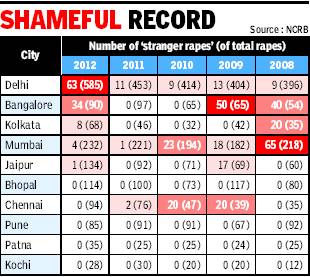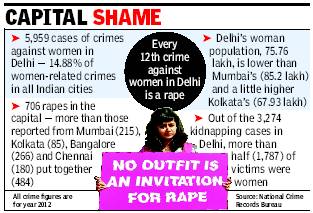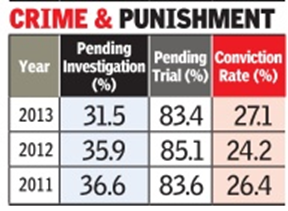Rape in India: longer- term statistics, analyses
All newspaper reports that looked into the issue of questionable allegations and over-reporting of Rapes in India have been shifted to the page Rape definitions unique to India
This is a collection of newspaper articles selected for the excellence of their content. |
Rape in India vis-a-vis other countries
Today India has the world's third biggest GDP in PPP terms--ahead of Japan and Germany. Does that mean that India is more prosperous than Japan, Germany, the UK, France, Italy, Switzerland ...? No, not at all. In per capita terms it is still a distant no.140 among the nations of the world, and per capita income is the real indicator. India's total economy is no.3 only because it is the world's second most populous nation, with 1.2 billion citizens.
Similarly, India has the second highest number of rapes: behind, of all countries, the USA which has only around a quarter of India's population. Does that mean that India is more unsafe than the countries with fewer rapes? No. In per capita terms it is near the middle ranks of the roughly 200 nations of the world. It is only because of India's absolute size that the total number of rapes is large. In per capita terms it is safer than the USA, most EU nations or even Japan. The likelihood of getting raped in India is lower than in these countries.
South Asia is the third safest region in the world. See below.
In absolute numbers
GlobalPost: India a distant no. 2 to the USA
In absolute terms India has the second highest number of reported rapes in the world (around 22,000) compared to the USA's "more than 80,000 cases of rape reported to the police from 2004 to 2010," according to GlobalPost. However, it adds, " But the US Justice Department estimates 300,000 American women are raped every year, and the Centers for Disease Control puts the number much higher at 1.3 million."
That is why estimates differ for most countries.
GlobalPost further states, " When looking at reported rape cases per capita, Australia, Botswana and Lesotho rank highest. But tallying sheer totals, Europe and the Americas consistently top the charts."
Annual statistics
See Rapes in India: annual statistics 2004 onwards
Rapes in per capita terms
India not in NationMaster's Worst 50
NationMaster's list of the 50 countries with the highest number of rapes per 1,000 of population in 2008 (in some cases, 2009) is as follows. It does not include India in the Top 50.
1 Lesotho 2 New Zealand 3 Belgium 4 Iceland 5 Norway 6 Israel 7 Finland 8 Chile 9 Mongolia 10 Ireland 11 Kazakhstan 12 Estonia 13 Luxembourg 14 Denmark 15 Germany 16 Argentina 17 Czech Republic 18 Mauritius 19 Lithuania 19 Kyrgyzstan 21 Moldova 22 Russia 23 Slovenia 24 Hungary 24 Romania 24 Poland 27 Latvia 28 Oman 29 Croatia 30 Belarus 30 Morocco 32 Slovakia 33 Bulgaria 34 Portugal 34 Bahrain 34 Liechtenstein 37 Malta 37 Philippines 39 Cameroon 39 Cyprus 41 Sierra Leone 42 Greece 43 Kenya 44 Canada 45 Japan 46 Maldives 47 Guinea 48 Azerbaijan 49 Armenia 50 Egypt
India not among HEUNI's worst 28 countries; South Asia is third safest
HEUNI took statistics from various 21st century years. Its list of the 28 countries with the highest incidence of rape is as follows. It does not include India:
Mexico (worst);
Republic of Korea
Mongolia
Namibia
Israel
Belize
France
Iceland
Norway
Scotland
El Salvador
Peru
Papua New Guinea
Panama
England and Wales
Northern Ireland
Belgium
Barbados
Nicaragua
United States of America
New Zealand
Zimbabwe
Sweden
Suriname
Jamaica
Canada
Swaziland
Australia had the lowest incidence of rape in this list of the world's 28 worst. Thus if Mexico was the worst, Australia was no. 28 from the bottom.
HEUNI's ranking for the best (least rape-prone in per capita terms) and worst regions of the world is:
Central Asia and Transcaucasian countries (best); Near and Middle East/ South West Asia; South Asia (third best); North Africa; Southeast Europe; East and South East Asia; East Africa; East Europe; West & Central Europe; Latin America and Caribbean; Oceania; Southern Africa; North America (worst).
Incidence of rape in UK, USA 1,500% higher than in India
614.4 million Women in India ensure safety for women tourists
TravelAndTourWorld Tuesday, August 27, 2013
India is one of the largest populated countries in the world with a population of over 1.27 billion people. With nearly half of her population being women, the country has one of the largest woman populations in the world at around 614.4 million.
According to the NCRB [India’s National Crime Records Bureau], 24,923 rape cases were reported countrywide in 2012 in India. A shocking number, definitely, isn’t that a trend worldwide? Are not women being assaulted all over the world? Actually women are safe in India just like they are in any other part of the world….maybe more so if statistics are to be believed…
Countries like South Africa lead in crimes against women.
Of every 100,000 people
132.4 women are raped in South Africa, while
the number is 63.5 for Sweden and
28.8 for UK.
USA also has a figure of 27.3,
Australia 28.6 and
New Zealand 25.8. Compared to them
India has a figure of 1.8
Do we infer from all these incidents that these places are unsafe for visitation by women?…
Women tourists are travelling to remote Indian villages regularly and they return with memorable and good experiences. A few cases do not mar the entire nation.
Every incidence of violence or rape reported is taken up with strict action by the law enforcement agencies of India and the assailant are subjected to adequate punishment just like it happens anywhere else in the world….
The Lancet: India and Bangladesh safest
1 in 14 girls is sexually assaulted’
London: New research to be published on Wednesday by the medical journal The Lancet on sexual violence shows India and Bangladesh have far lesser cases of rape and assault on women than developed countries like New Zealand or Australia. Worldwide, one in 14 women (7.2%) aged 15 years or less has been sexually assaulted at least once in their lives.
The Lancet looking at the prevalence of non-partner sexual violence in 56 countries found that countries with the highest rates of sexual violence are those in central sub-Saharan Africa (21%; DR Congo), southern sub-Saharan Africa (17.4%; Namibia, South Africa, Zimbabwe) and Australasia (16.4%; New Zealand and Australia). Countries in North Africa/Middle East (4.5%; Turkey) & south Asia (3.3%; India, Bangladesh) reported the lowest rates.
USA: 20% women been raped
Nearly one in five women -- up to 22 million people -- have been raped in their lifetime, according to a report issued Wednesday by the White House Council on Women and Girls.
President Obama said he has assigned a task force to address especially serious problems on college campuses where -- again -- one in five women reports being a victim of a sexual assault..
The report cited "the dynamics of college life" as a factor, noting that many victims are "are abused while they're drunk, under the influence of drugs, passed out, or otherwise incapacitated."
This epidemic of sexual assaults hurts all Americans, Obama said as he pushed new efforts to combat these crimes he called an affront to "basic decency and humanity."
The commission also recommended improved law enforcement -- including higher arrest, prosecution, and conviction rates -- as well as changes in a culture that too often turns away from the problem.
Citing government data, the report from the White House Council on Women and Girls says that 1 in 71 men -- nearly 1.6 million -- have been raped. Nearly 98% of assailants are men. Repeat attacks are common.
While women of all races are targeted, some groups are more targeted than others: 33.5% of multiracial women have been raped, according to the report, as have 27% of American Indian and Alaska Native women, 15% of Hispanic, 22% of black and 19% of white women.
Most victims are young. The report said nearly half the women who survived were raped before they were 18; more than one-quarter of male survivors suffered attacks before the age of ten.
EU: 5% woman raped; 32% experienced physical/ sexual violence
Violence against women: One-third of EU women affected – survey
By Bethany Bell BBC News, Vienna
BBC 5 March 2014
About a third of all women in the EU have experienced either physical or sexual violence since the age of 15, according to a survey by the European Union Agency for Fundamental Rights.
That corresponds to 62 million women, the survey says.
It is said to be the biggest survey conducted on the subject, and is based on interviews with 42,000 women.
It found that "one in 10 women has experienced some form of sexual violence since the age of 15, and one in 20 has been raped".
The survey noted that 22% had suffered from physical or sexual violence by a partner, but that 67% did not report the most serious incidents of domestic violence to the police.
About 18% of women said they had been the victims of stalking since the age of 15, and 55% said they had been sexually harassed, often in the workplace, the survey found.
The countries where women reported the highest number of incidences of physical and sexual violence were
• Denmark (52%), Finland (47%) and Sweden (46%), states that are often commended for gender equality. • • The UK and France reported the 5th highest number with 44% • • The lowest incidences of violence were reported in Poland with 19%. •
Wikipedia figures: India safer than most countries
According to Wikipedia the probability of rape (per 100,000 of population):
In 2004 was, India 1.6; Japan 1.7; Canada 1.8; Republic of Korea 13.5; Denmark 10.4; the UK 26.4; and the USA 32.3
By 2010, India’s record had worsened to 1.8; and UK to 28.8. Japan’s record improved to 1.0; Denmark’s to 6.4 (2009); and USA’s to 27.3.
Wikipedia, using regional groupings, lists India at no. 56, behind
41 Canada; 42 USA; 47 Hong Kong; 48 Japan; 50 Korea; 52 the Philippines; 53 Singapore; 54 Thailand; and 55 Bangladesh.
Maldives 57; Nepal 58 and Sri Lanka 59, follow. (Note: Wikipedia’s list seems to be region-wise, rather than according to the absolute or relative number of rapes.)
‘Stranger rape': in India and other countries
(Rapes committed by men who were strangers to the victim) The Times of India
‘Stranger rape’ goes [up from 2%] to over 10% [in India]
Rukmini Shrinivasan TIG 2013/06/15
New Delhi: Was 2012 the most dangerous year for women in the capital in the recent past? One statistic would seem to suggest so: the proportion of rapes committed by men who were strangers to the victim rose above 2% for the first time in five years to cross 10%.
‘Stranger rape’ of the type that occurred in Delhi on December 16 last year tends to form the basis for women’s perceptions of public safety, but is relatively rare. Rape in India, as in the rest of the world, remains overwhelmingly a crime committed by persons known to the victim. Atthe all-India level,lessthan 2% – 453 in all — of the nearly 25,000 rapes registered during the year 2012 were committed by strangers, data released on Wednesday by the National Crime Records Bureau show. In Madhya Pradesh, the state that consistently records the largest number of rapes, all of the 3,425 assaultswereby persons known to the victim.
In Delhi too, the proportion of stranger rapes has hovered close to the 2% mark over the last five years. However 2012 NCRB data for Delhi show that 63 of the 585 rapes that were committed in 2012, or nearly 11%,wereby strangers to the victim.
While data for Delhi have been stable over the previous years, large swings between years for a few other cities raise some doubts over the accuracy of NCRB data. Bangalore is the most extreme example of this: the proportion of ‘stranger rapes’ in the southern city swung from 77% to 0% between two consecutive years, 2009 and 2010. Karnataka’s crime statistics chief hadearlier toldTOIthat it was probably a problem with the numbers. “In Bangalore and Karnataka, as in the rest of the country, rape by strangers is a very small part of total rapes,’ Praveen Sood, additional DGP, Karnataka State Crime Records Bureau, had told TOI. A spokesperson for the Delhi police said he could not comment without the exact numbers in front of him.
It’s too soon to draw conclusions based on one year’s data, agreedKalpana Vishwanath of the Delhi-based women’s rights organization Jagori. “It’s undoubtedly a fact that there is crime against women, but there also seems to be some slight increase in the last six months. There is greater family and community supportto girlswhowantto speak out, and a little less of blaming the victim,” Vishwanath said.
Victims of rape also tend to be younger in cities than in the rest of the India, more so in Delhi. In the cities for which NCRB provides data, justover half the rape victims were aged 18 or less. The corresponding all-India figure was just 36.5%. In Delhi, 329 of the 585 victimes, or about 56.2% were aged 18 or less.
Worldwide: 31% of female victims were raped by a stranger
According to the U.S. Department of Justice: (All statistics are taken from: Violenceagainst Women, Bureau of Justice Statistics, U.S. Dept. of Justice, 1994.)
One of every four rapes take place in a public area or in a parking garage.
31% of female victims reported that the offender was a stranger.
Delhi: Accused known in 95% rapes
`Accused known in 95% rapes', June 12, 2017: The Times of India
In over 95% of rape cases, the survivor and the accused know each other, according to Delhi Police commissioner Amulya Patnaik.
According to statistics, 2,155 rape cases were reported in the city last year, and only 3.57% of them involved strangers.Patnaik also said the issue of women safety cannot be addressed by the police alone, but requires participation from various government departments.
2018: : ‘94% of offenders known to survivors
Ambika Pandit, January 13, 2020: The Times of India
NEW DELHI: The NCRB Crime in India report shows that almost 94% of rape cases registered in 2018 was committed by someone known to the survivor.
Highlighting the vulnerability of girls and women within their homes, neighbourhoods and workplaces, the report by NCRB (National Crime Records Bureau) said of the 33,356 rape cases in 2018, the offender was a family member in 2,780 cases.
In 15,972 cases, the offender was someone known, including neighbour, family friend and employer. In 12,568 cases, the accused was either a friend, online friend, live-in partner who lured the girl/woman on the pretext of marriage or separated husband. Only in 2,036 cases were the offenders either unknown or unidentified.
Of the 31,320 rape cases where the offender was someone known to the survivor, the highest number of such cases were reported from Madhya Pradesh (5,209), followed by Rajasthan (3,748) and Uttar Pradesh (3,718). In Delhi, of the 1,215 rape cases reported, the offender was known to the victim in 1,194 cases (98.3%).
A separate datasheet in the NCRB report on the age of rape survivors showed that girls and women of all age groups were targeted. As many as 9,433 (27.8%) were below 18 years and 281 of them were below six years. Of those below 18 years, 4779 (14.1%) were between 16-18 years, 3616 (10.6%) were between 12-16 years and 757 (2.2%) were between 6-12 years.
The data showed that 72.2% (24,544) were above 18 years with the maximum number (17,636) between 18 and 30 years, followed by 6,108 between 30-45 years. As many as 727 survivors were between 45 and 59 years. The survivors also included 73 women above 60. Fourteen of these cases involving elderly women were reported from Kerala, followed by 11 each from Madhya Pradesh and Maharashtra.
2018: 41% of those arrested for rape are friends or family
In rape cases in Delhi, 41% of those arrested are friends or family members of the victim. A Delhi Police study has found this.
The study has also found that only 3% of rapes are committed by strangers in the city. Data has found that 85% of rape cases in the capital were committed at the house of the victim or the accused and only 5% were committed at hotels or restaurants. Almost 98% of the cases were reported within three days of the crime being committed.
This year, altogether 487 rape cases were reported of which 76% were solved.
But there is a feeling that the actual figure could be much higher as cases are often not reported due to the stigma attached to them.
“When the victims know the accused, they hesitate to report the matter to the police even though we urge people to report such crimes in order to prevent them from continuing. However, it remains a challenge
for us and the society on how to convince the victims to report it to us,” said Delhi Police chief spokesperson Dependra Pathak.
According to another set of police data released last year, the 18-25 age group was found to be the most vulnerable. It was also found that most rapes were reported from areas around unauthorised colonies. Almost 70% of the accused were found to be from the city while the rest were migrants, and 95% of them were school dropouts. In 2017, 80% of cases were solved within 24 hours.
Police identify three major reasons for rape in these areas. They say the youngsters’ exposure to explicit content on the internet through mobile phones is a big reason. Moreover, the growth of colonies on the outskirts has resulted in large extended families staying together in one room leading to more contact, which eventually results in sexual assault. Lastly, the skewed ideas about men and women among youngsters leads to sexual violence.
Police say rape cases have come down by 1.2% while those involving molestation and ‘outraging modesty’ are down by 19.6% and 31.6% respectively.
Delhi, 2016-20: decline in stranger rape
Sakshi Chand, October 24, 2020: The Times of India
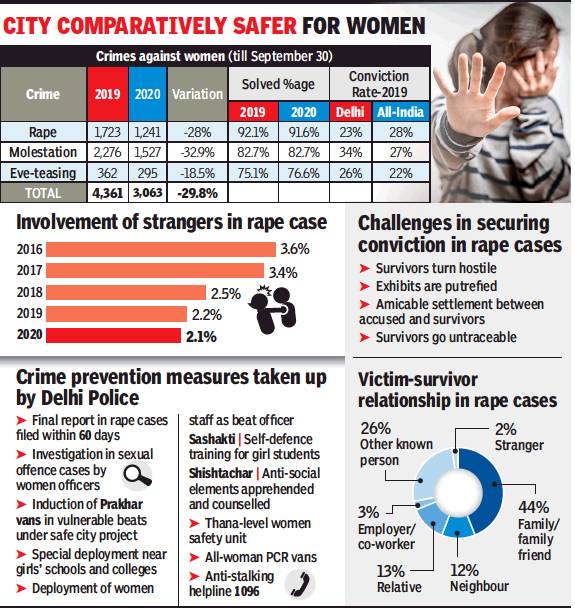
Involvement of strangers in rape cases, 2016-20
From: Sakshi Chand, October 24, 2020: The Times of India
Delhi Police’s latest data on crime against women shows a 28% fall in the number of rape cases in 2020. Similarly, molestation cases have gone down by 32.91% and cases relating to ‘outraging a woman’s modesty’ dipped by 18.51%.
At least 1,241 rape cases were reported this year till September 30 as compared to 1,723 cases in the corresponding period last year. And 1,527 cases of molestation were reported this year as against 2,276 in 2019. Analysis of rape cases shows that accused were known to the victims in 97.66% cases while rapes by strangers stood at 2.34%.
The case solving per cent in rape cases stood at 91.6%, molestations at 82.7% and insult to modesty at 76.6% in 2020.
The data shows that Delhi’s conviction rate is higher than the all-India rate. In molestation cases, the city had a conviction rate of 34% as compared to the national rate of 27%. Similarly, in cases of eve teasing, a conviction rate of 26% was reported as compared to the 24% all-India rate.
Delhi Police officials attribute the fall in crime against women cases to police commissioner S N Shrivastava's zero-tolerance policy. Soon after he took charge, Shrivastava had asked all district DCPs to directly supervise the investigation in rape cases. A scientific study was carried out to map areas, which reported more crime against women. The top cop then asked for intense patrolling in these areas.
Among other measures, action against people drinking in public places was given priority. “At least 28,375 persons were arrested for this offence in 2020,” a senior officer said, adding that these steps resulted in drastic reduction in crimes against women.
Not just the district police but the cyber unit of the Delhi Police also took timely action against online abusers, and people harassing women online were blocked. Civic agencies were instructed to make proper light arrangments in dark patches of the city and even offices where women worked late at night were told to take proper safety measures.
The police commissioner also directed district DCPs to ensure case investigations are done scientifically and in a timely manner. The police brass also enforced a 20 days’ time limit in filing of chargesheets in rapes cases after the arrest of the accused. The arrest of the accused was given priority. This led to a high solving rate in rape cases (91.62%) and molestation cases (82.71%) in 2020. Delhi Police also took several proactive measures to ensure that women feel confident in open spaces. All-women PCR vans have been stationed outside market places and in areas often frequented by women.
Delhi Traffic Police has also been tasked to challan vehicles having tinted glasses and pick-up vans illegally parked at bus stations. Apart from setting up women help desks, even the rape cases are handed over to women police officers so that victims feel comfortable in reporting the crime.
UP: 57% rapes on marriage promise; 37% accused known; 6% strangers
Pathikrit Chakraborty, October 22, 2020: The Times of India
Marriage promises led to 57% rapes in UP
LUCKNOW: The maximum number of rapes in Uttar Pradesh in 2019 — 57% of all cases — took place on the false promise of marriage, reveals the latest data released by the National Crime Records Bureau (NCRB).
The analysis of data further shows that in 37% cases in the state, the accused were known to the survivor, while around 6% perpetrators of the crime were unknown. Uttar Pradesh additional director general of police, prosecution, Ashutosh Pandey said, the data shows a distinct trend of rapes being committed by acquaintances of the survivors.
“Women should not keep mum if any acquaintance commits the crime. They should come up and report rape cases as this will help in higher reportage and conviction and send a clear message to the perpetrators of such crimes. Women should be made aware about the rules and laws which is now being done by the state government under the ‘Mission Shakti’ programme,” he further added.
‘UP’s conviction rate best in crime against women cases’
Besides, sustained and relentless efforts of the prosecution in perusal of cases has resulted in accused being held guilty in courts and as a result, UP has the highest conviction rate in cases of crime against women among all states, Pandey added.
“UP had the highest conviction rate of 55% in cases of crime against women, followed by 50% in Uttarakhand and 45.5% in Rajasthan,” the ADG said.
The prosecution department achieved a higher conviction rate because of technical advancements and easy availability of court proceeding details on the portalecourts.gov.in, he added.
The conviction rate is improving and in the last 24 hours, 11 persons were sentenced to life imprisonment. The convicts include Akash, who had brutally killed his mother by stabbing her 17 times in Sambhal.
Gajendra Saini, Murshid and three others have been sent to life imprisonment for murder of a child during dacoity in Amroha.
“In Amethi, Shivbahadur was sentenced to life for murder of his 11 month old son, and in Ayodhya, Rajkumar was sentenced to life for murder of his employer and attempt to murder of employer’s son,” said Pandey.
Six others were awarded 10 years’ rigorous imprisonment in cases of crime against women and were also slapped with fines.
Bails of 90 accused in 86 cases of crime against women got cancelled, while 29 accused were externed from districts, the ADG said. A helpline has been launched for providing free legal opinion to women who are victims of crimes. Besides, the prosecution also counsels and guides witnesses before they appear to testify in court in cases relating to crime against women.
Longer- term statistics analysed
Convictions, 2007- 2016: between 24 and 29%
Priya Kapoor, Over 30,000 rape cases; only 1 in 4 convicted, April 17, 2018: The Times of India
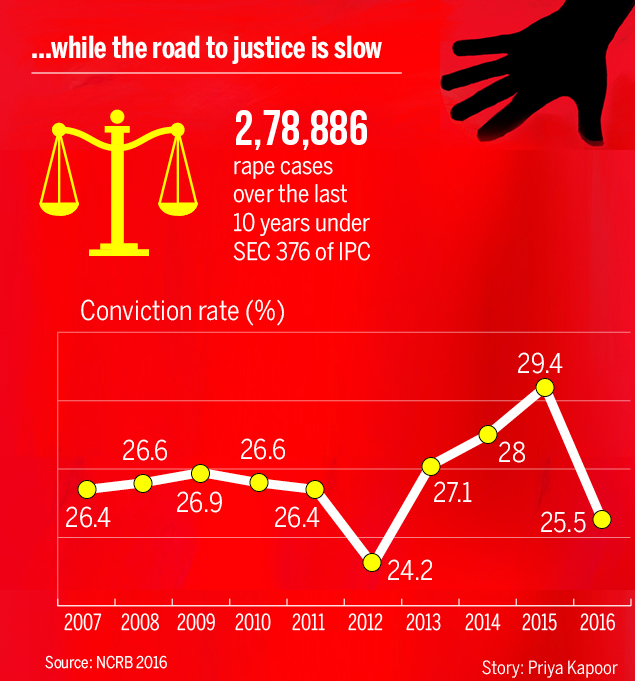
From: Priya Kapoor, Over 30,000 rape cases; only 1 in 4 convicted, April 17, 2018: The Times of India
The Unnao and Kathua rape cases draw attention to the fact that India remains largely unsafe for women. In 2016, of the 3.38 lakh crime cases against women, rape cases made up 11.5% of them. With 39 rapes per hour and only 1 in 4 rape cases ending up in conviction, it’s a painfully slow road to justice for rape victims in the country. What's worse? Our netas don't fare well either. Here's a look at the horrific number of rapes in the country and how many elected legislatures have cases of crimes against women.
Legislators and rape/ crimes against women

From: Priya Kapoor, Over 30,000 rape cases; only 1 in 4 convicted, April 17, 2018: The Times of India
See graphic:
Legislators and rape/ crimes against women, (presumably in 2016)
Parties with highest no. of MPs/ MLAs in crimes against women
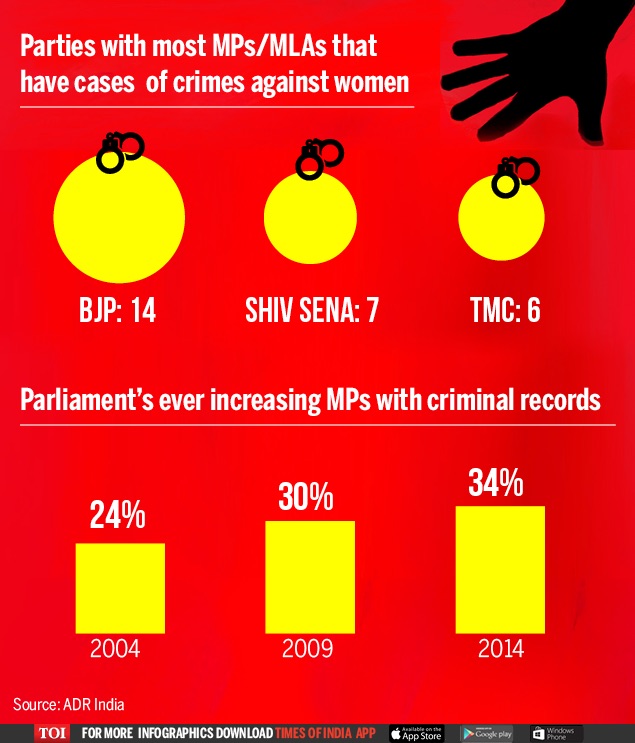
From: Priya Kapoor, Over 30,000 rape cases; only 1 in 4 convicted, April 17, 2018: The Times of India
See graphic:
Parties with the highest number of MPs/ MLAs involved in crimes against women, (presumably in 2016)
Rape numbers, in India, in 2016
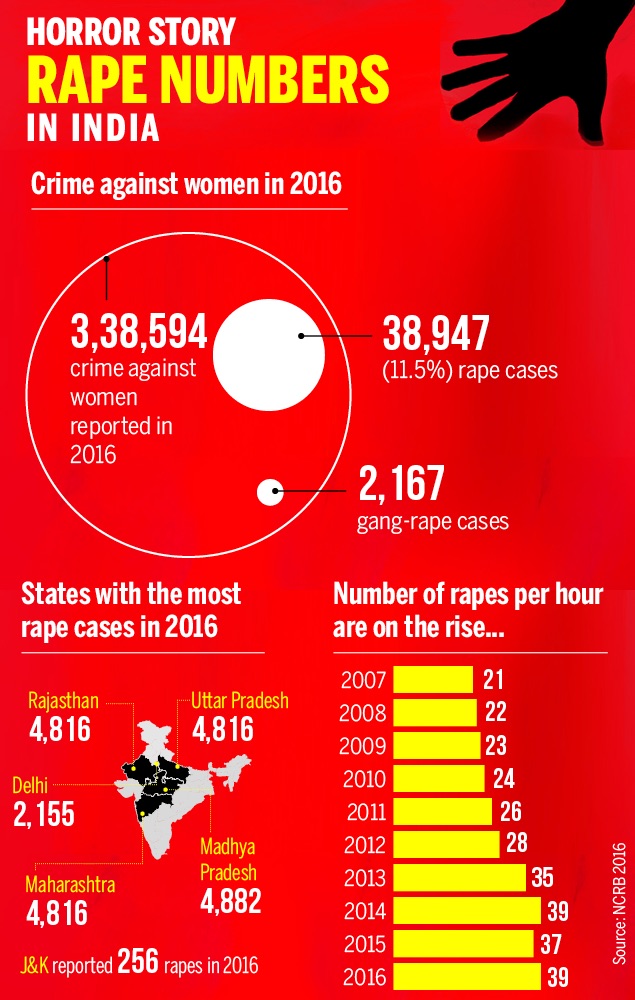
From: Priya Kapoor, Over 30,000 rape cases; only 1 in 4 convicted, April 17, 2018: The Times of India
See graphic:
Rape numbers, in India, in 2016
States with the most rapes cases
Number of rape case per hour, 2007-2016
Rapes in India's 5 biggest cities
More rapes in Delhi in 2012 than 4 metros put together
Dwaipayan Ghosh TNN 2013/06/14
New Delhi: Delhi’s shame continues. The National Crime Records Bureau’s report for 2012 iterates through statistics what every woman in the city knows by experience — that it remains the most unsafe for women among 88 important cities of India.
With 5,959 cases of crime against women registered last year, Delhi accounted for a staggering 14.88% of all women-related crimes reported from these 88 cities. No other city even came close to matching Delhi’s notorious record.
Bangalore was a distant second, with a share of 6.18% of all crimes against women in urban India. Next came Kolkata (5.66%) and then Mumbai (4.86%).
No crime reveals Delhi’s violence towards women better than rape. The number of rapes in the capital last year (706) was more than those reported in four other metros — Mumbai, Kolkata, Bangalore and Chennai (484) — put together. The staggeringly high figure can’t be explained by the capital’s sprawl. For, the female population of Delhi is 75.76 lakh, lower than Mumbai (85.20 lakh) and not much higher than Kolkata (67.93 lakh).
Rapes rise 200% in Kolkata in 5 years [2008-13]
Dwaipayan Ghosh, TNN | Sep 29, 2013
KOLKATA: The City of 'bhoi' is indeed living its worst nightmare. The number of rapes has almost doubled in the city since 2008 and molestation tripled, says the latest data of the National Crime Records Bureau (NCRB). The last NCRB study had ranked Bengal No. 1 in crimes against women.
Cruelty towards women has seen a 200% increase - from 405 in 2008 to 865 in 2012 - giving the city the ignominy of topping cases under Section 498A IPC. Even dowry death, which was on the decline in the late Nineties in Bengal, has seen a slight increase in Kolkata.
In 2008, 35 rape cases were reported in Kolkata, which rose to 42 the next year. Although it dropped sharply to 32 in 2010, the very next year it shot up to 42, and 2012 was the worst year with 68 rapes cases registered in the city.
Molestation cases increased even more alarmingly, from 81 in 2008 to 133 in 2010. And again, 2012 was the worst year, with 377 molestation incidents reported.
Some incidents this month itself raises a number of questions. A Class-X student of a leading south Kolkata school was molested while returning home in the Topsia-Tiljala area. A couple of days later, a young girl was raped in the same area. A woman returning home with her fiance was molested by bike-borne men near AJC Bose Road flyover and two female employees of an eatery in China Town were kidnapped inside a taxi and molested by three men.
Earlier, a 26-year-old woman was kidnapped and raped inside a moving car and a Frenchwoman was molested by a bike gang in the Lake Gardens area.
Age profile of the women raped; relationship profile of the rapists
See graphic:
Rapes in India in 2016:
i) age profile of the women raped;
ii) a profile of those who committed rape in 2016
Pendency 2019, Dec
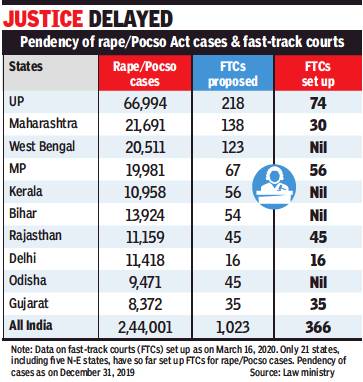
From: Pradeep Thakur, Rape trial: Target 1,000, only 366 fast-track courts set up, March 21, 2020: The Times of India
The government’s resolve to fast-track trials in 2.44 lakh rape and child sexual offence cases seems to be progressing at a snail’s pace. In the last six months, ever since the Centre announced setting up of 1,023 fast track courts (FTCs), only 21 states have come forward and set up 366 FTCs, including the five north-eastern states.
During the last one year, rape cases against women and children have increased by 46%, from 1.66 lakh in 2018 to 2.44 lakh in 2019 — about 96% of these cases are those against children booked under the Pocso (prevention of children from sexual offences) Act that mandatorily provides for completion of investigation within two months, from the date of registration of the FIR, and trial within six months.
According to data collected by the Union law ministry from various high courts, there are at least 389 districts in the country where the number of pending cases under Pocso Act exceeds 100. The government has allocated funds to these states and issued advisories to immediately set up FTCs in each of these districts.
However, a latest status report prepared by the law ministry reveals that only 21 states have so far set up FTCs — West Bengal, Bihar, Kerala and Odisha, which have high number of pending rape/Pocso cases, are yet to do that under the government’s proposed scheme of 1,023 FTCs.
Out of 366 FTCs set up so far, UP accounts for the highest at 74, followed by Madhya Pradesh (56), Rajasthan (45), Gujarat (35) and Maharashtra (30). “Share of funds have so far been released to 28 states for setting up of 651 FTCs with 363 exclusive Pocso courts out of which 366 FTCs with 273 exclusive Pocso courts have been established as per information received from high courts,” law ministry recently informed Parliament.
The law ministry has set a target of one year to complete trial of all 2.44 lakh pending rape/POCSO cases, by March 2021. The highest pendency has been in UP where the cases in absolute numbers has increased from 36,000 to 67,000 during March 2018 and December 2019. Maharashtra, West Bengal, MP, Bihar, Rajasthan, Delhi, in that order, are among the states that have reported highest pendency of rape cases after UP. Two states, UP and MP, have shown increase in pendency of rape cases by over 80% during this period while Delhi has shown a phenomenal growth of over 353% despite the fact that it has many FTCs already running to dispose of the pendency.
The highest pendency has been in UP, where the number of cases has increased from 36,000 to 67,000 during March 2018 and December 2019, a law ministry report said
Child rapes/ Sexual assault on children
See the page Crimes against children: India
Courts’ disposal of rape/ POCSO cases
2013: Conviction rate improves
Conviction rate went up in rape cases in 2013
Deeptiman Tiwary New Delhi:
TNN
The Times of India Jul 02 2014
Trial Rate Still Sluggish, Cops Pull Up Socks
Though the gruesome gang rape of Nirbhaya in December 2012 has pushed the rate of registration of rape cases by several notches, the National Crime Records Bureau (NCRB) 2013 data on pendency of cases with police and courts and conviction rates show much more needs to be done.
Police have improved perform ance slightly by bringing down the pendency of rape cases from 35.9% in 2012 to 31.5% in 2013. In 2011, the figure stood at 36.6%.
But courts remain as sluggish as ever with 83.4% rape cases pending trial and a conviction rate of 27.1%. In 2012, 85.1% of all cases were pending with the courts while conviction rate stood at 24.2%. In 2011, the same figures stood at 83.6% and 26.4%.
Cases of molestation and sexual harassment, too, have shown no improvement in pendency with courts with both notching figures of 85.7% and 77% respectively. In 2012 and 2011, too, the figures hovered around 85% and 75% for the two offences.
According to the data, in 2013, registration of cases involving crimes against women (rape, molestation and sexual harassment) have jumped by over 35% across the country while in Delhi, the figure is a record-breaking 140%-350%.
In cases of molestation and sexual harassment (that are now defined in law as assault to a woman with intent to outrage her modesty and insult to a woman's modesty), the performance of police has remained almost constant with 22.9% molestation cases pending investigation in 2013 as against 23.7% in 2012 and 21.6% in 2011. In cases of sexual harassment, too, the figure hovers around 20%. Even the rate of chargesheeting of investigated cases by police has remained constant for these categories, hovering in the range of 90-95%.
Cases pending, As in 2019 Dec
Pradeep Thakur, Dec 7, 2019 Times Of India
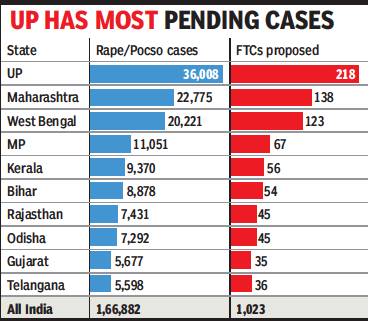
From: Pradeep Thakur, Dec 7, 2019 Times Of India
In a grim reminder that children continue to face the brunt of sexual depravity, more than 96% of the 1,66,882 pending rape trials are ones registered under the Protection of Children Against Sexual Offences (Pocso) Act.
The law ministry has now drawn up a comprehensive plan to fast track disposal of pending rape and Pocso Act cases within a year.
“The scheme envisages targeted disposal of 1,66,882 cases of rape and those under Pocso Act, which includes 1,60,989 cases of Pocso Act (as per data collected from high courts as of June 2019), within one year,” the law ministry has said. The government is also likely to propose a similar fast-track courts (FTCs) scheme under the 15th Finance Commission (2020-2025).
The combined data for rape and Pocso Act cases are of March 31, 2018, and those of only Pocso Act cases are of June 2019, both supplied by the HCs, having a time lag of a little over a year. However, the current status of the number of Pocso Act and other rape cases is unlikely to be too different from the available data set.
The law ministry has set a target of one year, spread over the 2019-20 and 2020-21 financial years, to complete trial of these pending cases by setting up 1,023 FTCs across the country.
The government has asked each HC and state government to convey their “desire to on-board the scheme” by December 31. Many states are already running FTCs for trial of Pocso Act cases.
“Pocso Act also mandates that investigation in the cases is to be completed in two months (from the date of registration of FIR) and trial in six months. However, despite a strong law and policy framework, a large number of rape and Pocso Act cases are pending in various courts in the country,” the ministry said. It, however, did not mention how long these cases have been pending.
The ministry, which has received data on all pending rape and Pocso Act cases from HCs, said there were 389 districts where the number of pending cases under Pocso Act exceeded 100. The government has issued directives to set up a Pocso Act fast-track court in each of these districts, which is also in compliance of a similar directive from the Supreme Court.
The department of justice in the law ministry will monitor these trials on a quarterly basis and each of these FTCs will be connected to the National Judicial Data Grid (NJDG), which updates status of all cases on a daily basis, including their disposal.
“Data will be collected from quarterly reports submitted by high courts and the NJDG database by the department of justice. It will analyse the data and draw a comparative analysis of performance of FTCs to identify good practices and performance,” the ministry said.
Pocso Act, notified in 2012, provides for special courts for trial of cases of crimes against children to protect minors and prevent them from being victimised again by courts which have to deal with long pendency of other cases. A Pocso Act court has provision for in-camera trial in a child-friendly environment without revealing the identity of children.
The government informed Lok Sabha on Friday that 218 FTCs to be set up in UP for expeditious disposal of cases.
Is rape under-reported (or over-reported) in India?
All newspaper reports that have looked into this issue have been shifted to the page Rape definitions unique to India
Rape reporting went up 33% in 2013-16 over 2005-12
Ambika Pandit, ‘Nirbhaya effect’ strongest in Delhi, vicinity, November 25, 2018: The Times of India

From: Ambika Pandit, ‘Nirbhaya effect’ strongest in Delhi, vicinity, November 25, 2018: The Times of India
The Nirbhaya case and the revision of laws relating to crime against women saw a nationwide increase in reporting of rape cases — but the pattern is not uniform as the spike is more noticeable in regions closer to Delhi and tends to weaken farther from the capital.
Crime data analysis before and after the 2012 Nirbhaya gang rape case, which sparked national outrage, reveals significantly higher reporting of rape cases in the nearby districts of Haryana, Punjab and Rajasthan since 2013. But the trend falters in districts distant from Delhi, cases reported till 2017 show.
After scouring National Crime Records Bureau data, a team from the Center on Gender Equity and Health at the University of California (San Diego) found the Nirbhaya case had a profound, though uneven, impact on reporting rape. Subsequent to the Nirbhaya case, for every additional 100km from Delhi, there is a decrease (0.16 fewer per 100,000 women) in rape cases reported. A district-wise analysis indicated that distance from Delhi, presence of women’s police stations, sex ratio and literacy ratio could be factors in reporting of rapes.
Rape reporting went up 33% in 2013-16 over 2005-12
But the analysis clearly established that rape reporting between 2013 and 2016 shows an increase of 1.4 rapes reported per 100,000 women, a 33% increase as compared with the 2005-2012 period.
Interestingly, the study also found that districts that had all-woman police stations saw much smaller increases in reporting post-Nirbhaya than those that did not. Their explanation for this phenomenon is that it could be because there was already higher levels of reporting happening where such police stations had been set up and hence less of a reporting deficit to be bridged than in districts without all-woman police stations.
The district-level data of rapes reported to police in 2011-12 and 2013-14 threw up more details. “Though the increase seen at the national level was noted, district-level mapping reveals greater heterogeneity in the annual rapes statistics,” said Dr Anita Raj, director of the centre at UCSD.
Higher levels of “absolute change” were seen in districts in Delhi, Punjab, Rajasthan, Haryana and Madhya Pradesh. However, little change was found in West Bengal, Andhra Pradesh and Tamil Nadu. Districts that were farthest from Delhi have the lowest increase from 2012 to 2013.
Apart from the geographical variable, media access was also associated with increased rape reporting: For every 10% increase in number of household TV sets, there was an increase of 0.3 rapes reported, and for every 10% increase in households with access to internet, the increase is 1.3 rapes reported.
According to the report, incidence of rapes annually reported at the national level increased by 79% between 2005 and 2016. “However, throughout this period, rape case progression through police and court systems remained relatively static. Of all rapes reported to police in India over the past decade, 63% to 70% of investigations have concluded, and chargesheets were filed in 86% to 89% of concluded investigations. But only 12-20% of rape trials have been completed, with a conviction rate of 24% to 29%,” said project lead Lotus McDougal.
Slow pace of trial and low conviction rate have been cited to be major challenges that need to be addressed to enable women to come forward and report such crimes.
Delhi-based research scientist Nandita Bhan shared that triangulated data from NCRB (2005-16), Census (2001 and 2011) and World Bank’s population estimates (for India for 2017) were used to assess the trends in rape reporting at national and district levels using regressions, spatial mapping and graphical trend analysis.
See also
Crimes against children: India
Juvenile delinquency in India Especially the section 'Rape by juveniles'
Juveniles, benefits and privileges of
Rape definitions unique to India
Rape in India: longer- term statistics, analyses
Rapes in India: annual statistics
Rapes in India: Compensation and help for survivors
Rapes in India: court verdicts
Rapes in India: the legal position after 2013
Sexual harassment in India's media, entertainment, advertising industries; academics
